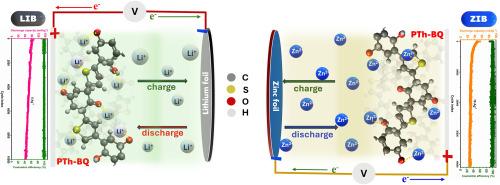用于非水锂离子和锌离子电池的稳定、高倍率的苯醌-噻吩共聚物电极
IF 8.9
2区 工程技术
Q1 ENERGY & FUELS
引用次数: 0
摘要
有机分子及其衍生物由于其设计的灵活性和良好的理论容量而成为金属离子电池的高效电极材料。然而,诸如在电池溶剂/电解质中的高溶解度和低本征电子导电性等问题阻碍了它们的广泛应用。本研究通过简单的制备策略合成了一种富羰基的醌-噻吩共聚物(PTh-BQ),并将其作为非水锂离子电池和锌离子电池的电极材料。在聚噻吩链中加入醌单元提高了其电荷存储性能。该聚合物在1 Ag−1下的稳定容量约为137 mAhg−1,库仑效率为99.9%,在锂离子电池中循环5000次后容量保持率为83%。对于锌离子电池,在5Ag−1条件下的稳定容量为71 mAhg−1,在10ag−1的高电流密度下的稳定容量为43 mAhg−1,循环次数达10,000次,容量保持率几乎为100%。利用x射线光电子和红外光谱研究,了解了噻吩和醌基团在金属离子储存中的作用。目前的研究为开发噻吩基聚合物电极提供了一种方便和有前途的方法,并为设计用于储能的共轭有机聚合物开辟了一条新的途径。本文章由计算机程序翻译,如有差异,请以英文原文为准。

Stable, high rate capable, benzoquinone - thiophene co-polymer electrode for non-aqueous lithium-ion and zinc-ion batteries
Organic molecules and their derivates have evolved as efficient electrode materials for metal ion batteries due to the flexibility in design and good theoretical capacities. However, issues such as high solubility in battery solvents/electrolytes and low intrinsic electronic conductivity hinder their widespread use. In the present study, a carbonyl-enriched copolymer of quinone and thiophene (PTh-BQ) synthesized by a facile preparation strategy, is explored as an electrode material in non-aqueous lithium-ion and zinc-ion batteries. The incorporation of quinone units in the polythiophene chains enhances its charge storage properties. The polymer delivers a steady capacity of around 137 mAhg−1 at 1 Ag−1 with a coulombic efficiency of 99.9 % and a capacity retention of 83 % after 5000 cycles in lithium-ion batteries. For zinc-ion batteries, a stable capacity of 71 mAhg−1 at 5Ag−1 and 43 mAhg−1 at a high current density of 10 Ag−1 up to 10,000 cycles with almost 100 % capacity retention is observed. Participation of both thiophene and quinone groups in metal ion storage is understood using X-ray photoelectron and FT – IR spectroscopic studies. The current research promotes a convenient and promising way to develop thiophene-based polymer electrodes and opens a new avenue of designing conjugated organic polymers for energy storage.
求助全文
通过发布文献求助,成功后即可免费获取论文全文。
去求助
来源期刊

Journal of energy storage
Energy-Renewable Energy, Sustainability and the Environment
CiteScore
11.80
自引率
24.50%
发文量
2262
审稿时长
69 days
期刊介绍:
Journal of energy storage focusses on all aspects of energy storage, in particular systems integration, electric grid integration, modelling and analysis, novel energy storage technologies, sizing and management strategies, business models for operation of storage systems and energy storage developments worldwide.
 求助内容:
求助内容: 应助结果提醒方式:
应助结果提醒方式:


